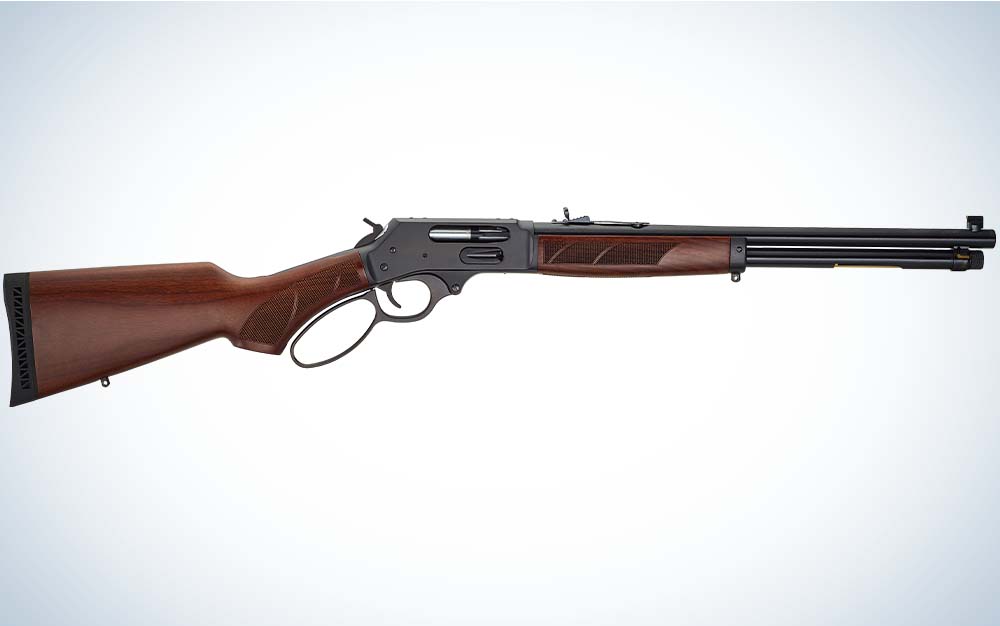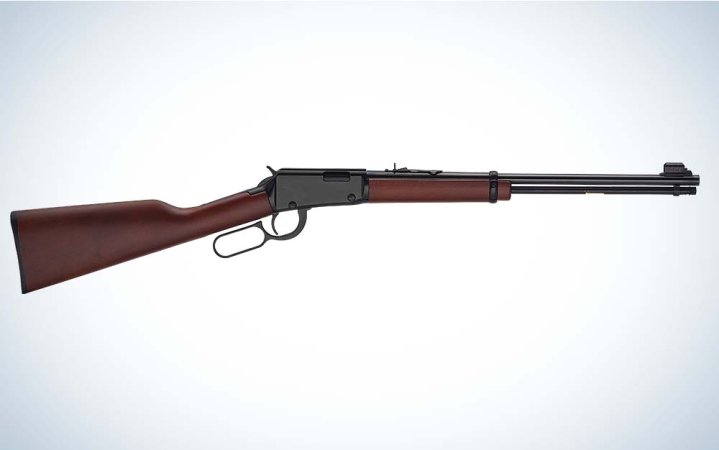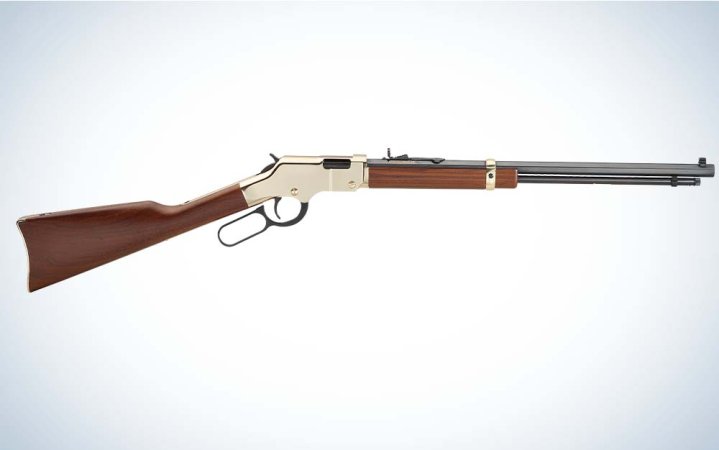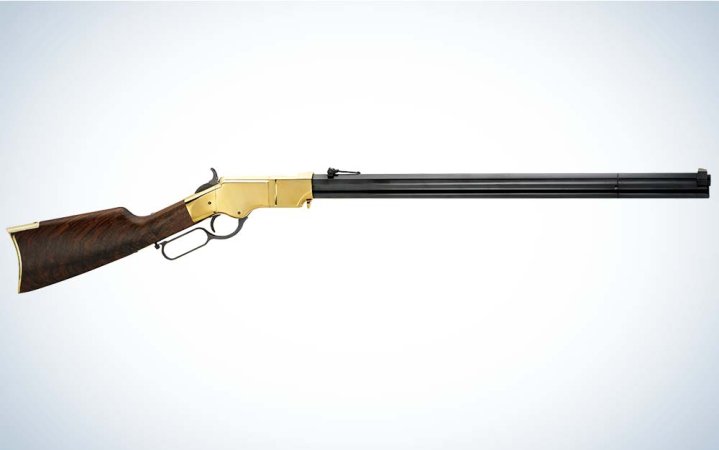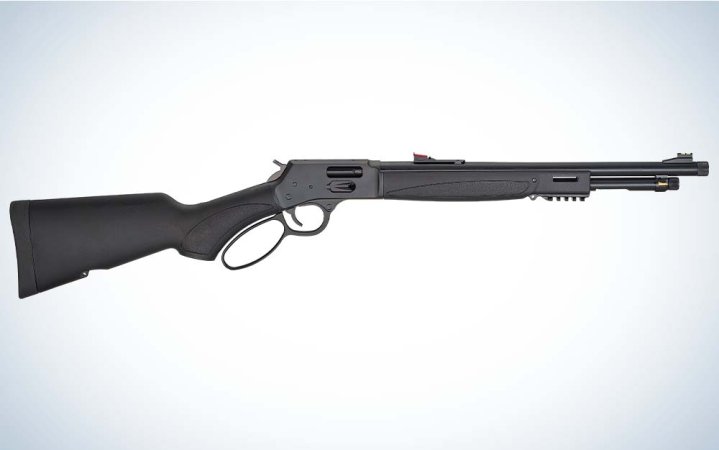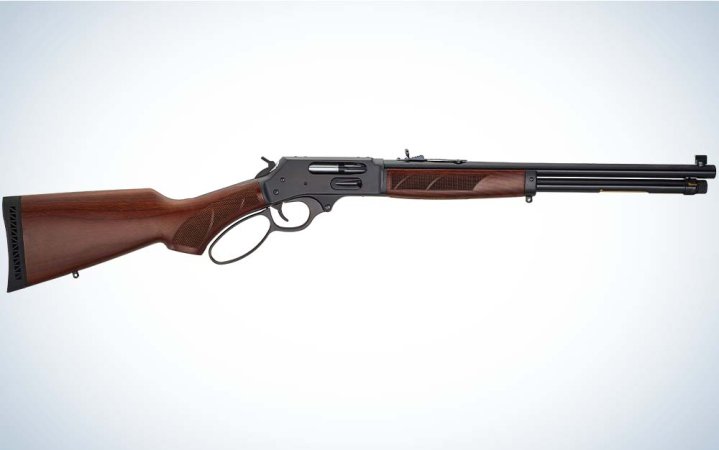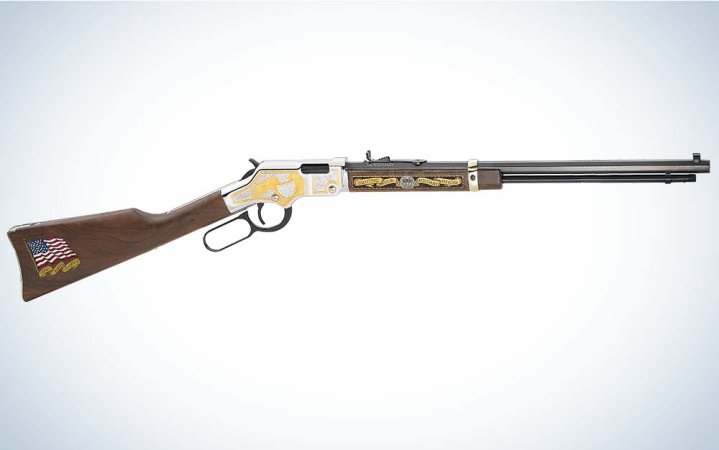We may earn revenue from the products available on this page and participate in affiliate programs. Learn More ›
Benjamin Tyler Henry was not the father of lever-action rifles, but his development of a .44-caliber cartridge—and the lever gun he built to shoot it—did change the platform forever. Only 14,000 of Henry’s original rifles were made, but you will see the unique profile of his gun replicated in many lever-action rifles, particularly those in the Winchester stable of firearms.
The life of the first Henry rifle was short (just five years), but after more than a century on the shelf, the company returned—in name—when a father and son started a new lever gun company in Brooklyn, New York, and settled on Henry Repeating Arms. Today, there are countless numbers of popular Henry lever gun models. Dan Clayton-Luce is Henry’s communications director and unofficial historian. I asked him to help me pick the top six rifles from Henry—a difficult task. He rose to the occasion, basing his choices on sales, originality, and historical significance.
Here, in no particular order, are the six best Henry rifles at this moment in time.
1. Lever Classic .22
The Henry Lever Classic .22 is the one that started the company and continues to be a best seller with over 1 million sold. One of my shooting buddies has the .22 Mag version and I have shot it a lot. I can find only one flaw with the rifle and that is that it’s not mine. The Henry Lever Action rifle is fitted with an American walnut stock that mates well with the blued metal. The rifle has side ejection, an adjustable rear sight, a hooded front sight and a 3/8″ grooved receiver for mounting a scope. The barrel length is 18-½ inches, overall length is 36½ inches and it weighs in at 5¼ pounds. The tubular magazine holds 15 rounds of .22 LR, 17 rounds of .22 Long, and 21 rounds of .22 Short. It’s also available in .22 Magnum and .17 HMR.
2. Golden Boy
The Golden Boy is the rifle that really put Henry on the map. It looks like it came out of the 1860s with a brass colored frame, walnut stock, and octagon barrel. At first glance it resembles a scaled down Winchester Model 1886, the rifle the Native Americans called the Yellow Boy. Both are rimfires, but the original used the .44 Henry Flat cartridge while the new Yellow Boy uses modern rimfires. The rifle will take .22 LR, .22 Long and .22 Short. There are also variants in .22 Magnum and .17 HMR. There is even a shortened youth model. The rifle weighs in at a hefty 6¾ pounds. This too is historically accurate as the original 1866 was not a lightweight. It has an adjustable buckhorn-type rear sight. The .22 S/L/LR version holds 16 rounds of Long or Long Rifle, or 21 rounds of Short. The .22 Mag can carry 12 rounds and the .17 HMR holds 11.
3. The New Original Henry
This is a modern day Henry rifle, made as historically true to the 1860 design as possible. The Henry is not an easy gun to manufacture and most imported reproductions take shortcuts, this gun does not. The only concession is it’s chambered for .44-40, the cartridge that replaced the .44 Henry rimfire when the Winchester 1873 rifle came out. That’s because nobody makes .44 rimfire and a rifle would be useless chambered for that cartridge if you couldn’t buy ammo. Several ammo companies of note make .44-40 and it’s easy to reload. The gun is also offered in .45 Colt. Both have 13 round magazines, as these cartridges are a bit longer than the .44 Henry. Historically, no Winchester rifle was ever chambered for the .45 Colt, mostly because it was difficult to make it work in a rifle. But, today’s engineers figured it out and it matches up easily with modern .45 Colt handguns. That makes this rifle a good pick for cowboy action shooting, historical reenactments, or just having fun shooting.
The rifle has a one-piece 24.4-inch octagon barrel and integral magazine, which is what makes it so hard to manufacture. Also fancy grade American Walnut stocks, a folding ladder rear sight and blade front. As a concession to safety the rifle has a half-cock safety hammer notch, but it does not have any of the foolish, lawyer inspired modern manual safeties.
4. Big Boy X
If you are of the mindset that Henry lever action rifles are nostalgic echoes of the past bought by aging boomers, you need to check out this rifle. There is a modern movement that has developed the concept of a “tactical” lever-action rifle. Many recognized that a lever action rifle, particular one in a potent pistol cartridge, can be a viable home defense gun. In fact I devoted an entire chapter to this in my book, “Prepper Guns” to that very subject.
This gun is available in .45 Colt, .357 Magnum/.38 Special and .44 Magnum/.44 Special. Clayton-Luce said that the .357 Magnum, which can also use .38 Special, is by far the best seller. With good reason, the .357 Magnum is formidable when used in a rifle. It’s even effective for deer hunting at close range. As a defensive round it’s nearly a perfect balance of power and controllability. This rifle has a threaded muzzle to allow for a suppressor. There are M-Lok and Picatinny attachment points to add a light or laser. This is a serious rifle with a lighter fun side.
5. Steel Lever Action .45-70 Side Gate
OK, so not a lot of creativity went into naming this gun. The .45-70 was developed in 1873 for the Springfield “trap-door” single shot rifle. In truth, it should have died there. Except that the lever action rifle came along with life support. Winchester chambered it in their 1886 rifle and it became arguably the most popular cartridge in that rifle. Sadly, the Great Depression killed off the 1886 in 1935.
That would have been the end for the .45-70. Except that in 1972 Marlin introduced their modern Model 1895. (They made an 1895 in the 1800s too.) The new rifle is based on their 336 frame and chambered for .45-70, which saved the cartridge. About the time that Remington bought Marlin, the .45-70 was becoming a best seller. Most buyers were looking for a shorter barrel and more compact gun for hunting and bear protection. Then Remington went bankrupt and production stopped. Ruger had just recently introduced a new Marlin .45-70. But, in the meantime, those shooters looking for a high quality, drama free, lever action in .45-70 turned to Henry.
This model Henry in .45-70 has an 18.5-inch barrel so it’s short and handy. Like all the side gate loading Henry rifles, it also maintains the option of loading through the top of the tube. This gun weighs in at seven pounds so it’s easy to carry and won’t beat you up with hot loads.
The gun can handle modern .45-70 ammo, which means it will stop a charging grizzly. I have used the .45-70 on two bison as well as black bears, whitetails, hogs, and other game. It’s always impressive. This rifle is great for hunting in the thick stuff and it would be a solid choice for deer season. The truth is that with proper ammo, the cartridge can handle anything in North America.
The .45-70 is legal in most “straight walled cartridge” hunting areas and you would be well served with a Henry rifle. There are 16 other variants, including stainless steel, synthetic stock models; and a color case-hardened receiver with straight or curved lever option.
6. The Long Ranger
If you want to be the modern leader in lever action rifles, it only makes sense to have a lever action rifle chambered in modern cartridges. This rifle is offered in .223 Rem/5.56 NATO, .243 Win, .308 Win, 6.5 Creedmoor. I don’t know what their best seller is, but everybody I know who bought one of these rifles has a 6.5 Creedmoor, of course. The Long Ranger has an exposed hammer with a transfer bar safety system. It uses a geared action and a chromed steel bolt with a six-lug rotary locking head. The lock up is similar to a bolt action rifle which is how it can handle the pressure of modern cartridges.
It features side ejection for easy scope use. The receiver is lightweight aluminum alloy. The gun uses a steel-bodied, flush-fit detachable magazine. It has a five-round capacity in .223 and four-round for everything else. The Long Ranger includes a 20-inch free floated barrel, except for the Creedmoor which uses a 22-inch tube.
The rifle brings new level of accuracy to the lever action design. It’s a great choice for big game hunters anywhere. Now if we could only convince them to make it in .358 Winchester.
Bonus Gun: Military Service Tribute 2nd Edition Rifle
There is a tradition dating back to the Civil War, for ornately engraved Henry rifles to be presented to veterans as tokens of appreciation. The Military Service Tribute Edition keeps that alive and is a good choice for anyone looking for a gift for a veteran. It is based on the Golden Boy and chambered in .22 Long Rifle, .22 Long, and .22 short.
The rifle features a highly-polished nickel-plated receiver cover with intricate scrollwork and a bald eagle surrounding a shield bearing the words, “In Recognition of Military Service to our Great Country” on the right side. The left side has the Statue of Liberty next to the Liberty Bell. All images and the laurel leaf borders that surround them are selectively plated with 24K gold. The right side of the fore-end has a banner reading, “Saluting our Military Heroes.” The buttstock has an American flag and “God Bless America” on the right side.
Henry donates thousands of dollars—and many guns—to veteran’s causes and to military veterans, as well as many other worthy causes each year.
B. Tyler Henry Worked for the Best Lever-Action Gunmakers in History
The history of the lever action started with Walter Hunt in 1848 when he developed the “Rocket Ball and Volition Repeater.” This was a lever action, breech-loading, repeating rifle with an under-the-barrel tube magazine—a design most lever actions followed. That rifle used a cartridge of sorts. It featured a hollow base, conical bullet with the powder charge contained in the base. A separate primer ignited it, so it wasn’t exactly a self-contained cartridge, but the bullet and propellant were a single unit. But it was not very powerful.
Hunt later teamed with George Arrowsmith and Lewis Jennings and was granted a patent for the Jennings improvement in 1849. Five thousand of the Jennings repeater were contracted to be manufactured in Vermont (only about 1,000 were produced). The foreman in that factory was Benjamin Tyler Henry, a man that would later prove very important in the development of the lever action rifle.
In 1854 Smith & Wesson developed the lever action, under the barrel tube magazine pistol to be made in Norwich, Connecticut. Their shop foreman? None other than B. Tyler Henry. After the production of about 1,000 of these guns, the name of the company was changed to Volcanic Repeating Arms Company.
Joining this company as an investor was a men’s garment maker named Oliver F. Winchester. In 1856 a new plant was built in New Haven, Connecticut. By 1857 Winchester owned most of the stock for the company manufacturing lever action Volcanic rifles and pistols. The name of the company was changed to The New Haven Arms Company. The shop foreman: B. Tyler Henry.
Henry’s First Lever Gun

Henry later developed a successful rimfire .44-caliber cartridge that was powerful enough to attract the attention of serious shooters. He also developed a new lever-action rifle called the Henry to go with that bullet. Production started on the 16-shot Henry rifles in 1860. By 1862 there were enough in the field that the rifle gained a reputation as a formidable firearm.
The first 300 guns made in 1860 and 1861 had iron frames. After 1861 the gun featured a brass frame. There were about 14,000 rifles made in total. Early production used a rounded heel, crescent shaped buttplate. Rifles made after 1862 had a sharper heel, crescent shaped buttplate.
The Henry rifle used a rimfire cartridge with a copper case, called the .44 Henry Flat. This featured a 200-grain heeled lead bullet with 26 to 28 grains of black powder. That produced 1,125 fps and 568 foot-pounds of muzzle energy. Cases later were made from brass and there was also a load with a 216-grain heeled bullet at some point. There were apparently two different length cases used during the lifetime of this cartridge which was loaded by Winchester until the 1930s.
Henry’s rifle had a 24-inch octagon barrel with an integral magazine tube below. That magazine held 15 .44 rimfire cartridges, giving the rifle a 16-shot capacity. However, the hammer had no half cock and rested on the firing pins, which were in contact with the cartridge. That was dangerous, as the gun would fire from any blow to the hammer. So, one might speculate that it was common to carry the gun with an empty chamber. In that case, the capacity was 15 rounds.
The Henry used two opposing firing pins to help ensure ignition. There was no forend on the rifle, so gripping the barrel in a firefight was a sizzling event.
To load the gun, a lever protruding from the magazine was pulled up a slot running the length of the magazine against a spring and then turned with the top of the magazine, pivoting on the barrel to lock it in place. The cartridges were inserted into the magazine through the top, and when full, the top of the magazine tube was turned back into alignment with the main tube and the follower was released to contact the cartridges and apply spring pressure.
The toggle link action of the Henry rifle was not a new concept, but it was perfected enough that it worked reliably. It also created the iconic profile of the action; easily recognizable and used in several Winchester rifles to follow.
In an odd turn of events, the Union Army looked at the Henry and decided that a trap-door Springfield rifle would be better for battle. Chief Ordinance, Brigadier General James W. Ripley didn’t like repeaters and told Lincoln that “single shot guns could be loaded and fired quickly enough.” He was also cheap, as the Springfield was far less expensive than the Henry.
Still, some Henrys made it into action during the Civil War, prompting a Confederate chief named Mosby to call it “a gun they wind up on Sunday and shoot all week.” He added that it was useless to fight against them.
The Henry Rifle Legend
One widely publicized incident helped to sell this rifle. Captain James M. Wilson of the 12th Kentucky Cavalry was accosted by seven men while dining at home. They entered his house, guns blazing. All they hit was the glass his wife was drinking from.
Wilson convinced them to kill him outside so his family wouldn’t have to watch. Once outside, he ran through a storm of bullets for cover in a crib he had near his house. There he grabbed his Henry rifle and killed the seven bad guys with eight shots, proving beyond all doubt that the Henry was the gun to have when your life depended on shooting fast and well. Even the extra shot counted as it removed several fingers from one of the bad guys as he grabbed the saddle horn to mount his horse. The next shot ensured that he really didn’t mind.
In 1866, the New Haven Arms became Winchester Repeating Arms. They introduced an updated and improved Henry-style rifle called the Winchester Model 1866 lever action, nicknamed the Yellowboy. The primary difference was that it loaded through a gate in the side of the receiver and had a wood forend so the shooter didn’t burn his hand on a hot rifle. The biggest legacy of the Model 1866 is that it replaced the Henry, which was taken out of production. It is said that Winchester also cheated Henry by doing an end-run on his patents with the Model 1866.
The Henry Rifle burned bright, but flamed out quickly with only a five year life span. It was, however, a hugely important firearm and it is imbedded deeply into the Great American Story.
New Henry, New Guns

Fast forward to 1996, 130 years after the last Henry rifle was made. Anthony Imperato owned Colt Blackpowder Arms in Brooklyn, New York. He and his father Louis decided to start a new gun company. Anthony took out a second mortgage on his house and put everything he owned on the line for the new gun company.
“My father had owned Iver Johnson and still had the rights to the name at that time. We argued a bit about using it for the new company, but I prevailed,” Anthony said. “We needed a name and as we were going to produce lever action rifles, what better choice than Henry? The lever action is the American rifle. Most of the other rifle designs originally came from some place other than America, but the lever action was invented here and has been America’s rifle. Henry really started the lever action in America and that name just felt right. It feels like America. So we found out it was available and that became the name of our new company.
“I like to think my father is sitting with B. Tyler in heaven and watching over the company carrying his name and his vision.”
In talking with Anthony it’s clear that he cares very deeply about his company, products, and customers.
“It’s simple,” he said. “I knew that launching a new company would not be a 9 to 5 thing. It would mean long hours and few days off. I wanted to locate it close enough to my home so that I could have time with my family as well. I wanted a place close enough that I would not need to waste time commuting when I could spend that time with my family.”
Anthony and Louis started Henry with a lever action .22 rimfire and some unique approaches to advertising and promotion. They promised that the guns and all the parts would be made in the U.S. and that the quality would be top of the line. The rifle was not cheap compared to other .22 rifles, but you get what you pay for and the shooting world took notice.
Read Next: Best Lever-Action Guns of All Time
Now, 25 years later, Henry is the country’s largest manufacturer of lever action firearms, with so many models I can’t count them all. They also have a pump-action rimfire rifle. I have one, it’s outstanding. They make shotguns, including a lever action .410 as well as traditional single-shot shotguns. They also make some single-shot rifles, bolt-action youth rifles and even the AR-7 Survival rifle.
